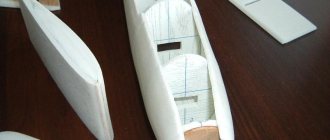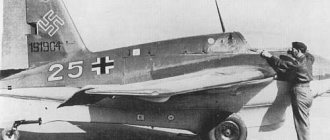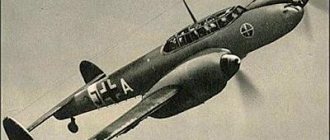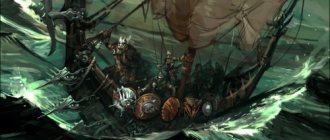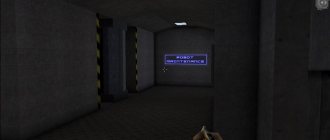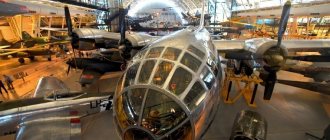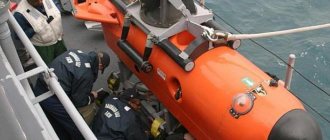Production of small cars
Microcars didn't take over the market, but they certainly helped fill the gap between full-size car production and the growing demand for own vehicles in post-war Europe. Microcars were small, cheap and easy to make.
Although the production of this segment of cars dates back to the beginnings of the automobile industry, it was not until the 1950s that they gained greater popularity and gave way to conventional cars in the mid-1960s. Interestingly, these days we can see a resurgence of small cars, driven primarily by low production and operating costs, as well as ease of use in large and crowded cities.
Plus the Eastern Front.
0
In general, the plane turned out thanks to the efforts of the company, which completed the development of the DB 601E engine with a take-off power of 1350 hp. and rated power 1270 hp. at an altitude of 2000 m. The prospect of increasing the performance characteristics and combat load loomed, and so, in fact, “Friedrich” appeared. An interesting feature of the engine was the system of direct fuel injection into the cylinders, which ensured normal engine operation in any attitude of the aircraft, under negative and positive overloads. The Friedrich propeller was equipped with an electric propeller pitch regulator (the prototype of the future Commandogerat), and its design allowed the pilot to turn off the automation and control the propeller pitch manually, as the Emile pilots did.
0
In general, the new aircraft was rated very highly by pilots, but a big disappointment was the significant weakening of firepower. In general, the Friedrichs initially intended to equip them with a 20-mm MG 151 motor cannon, which had a higher rate of fire compared to previous MG/FF cannons. However, they didn’t have time to finish the MG 151, so they started installing the same MG/FF in the cylinder camber. But they didn’t put cannons in the wings. The practice of using Emils has shown that for MG/FF in the wing the main task is to get somewhere at all. Accordingly, the number of cannons on the first Bf 109F decreased by one compared to the Bf 109E, and the mass of a second salvo was almost halved.
0
We look at the table, in which Soviet fighters and the American Tomahawk, which fought in North Africa, again appeared. What happens? Absolutely average again. Absolutely in all respects. Okay, let's just move on.
BMW Isetta
One of the most famous and undoubtedly most popular microcars in history is the Isetta. It was created in Italy in 1952 on the initiative of Iso Autoveicoli owner Renzo Rivolta, who wanted to expand the company's offer (production of small vans, scooters and... refrigerators) by offering a cheap and small car.
What to wear with jeans this spring: a selection of fashionable looks for every day
Good deeds and donations: a quick and easy way to become happier
Stylish, light and cozy: a couple made a two-tier residential house from an old barn
The project was created by Ermengelido Preti and Pierluigi Raghi. The car they designed was only 2.3 m long and 1.37 m wide. Under the hood was a small 236 cm³ single-cylinder engine, providing a top speed of 75 km/h. It took 30 seconds to accelerate to 50 km/h.
The Isetta had only one door at the front, so it had no crumple zone, and in the event of an accident (if the passengers survived) they could only exit through the opening roof.
By 1955, 1000 copies of the Italian Isetta were produced. That same year, the company sold its production license to France, Brazil, the UK and Germany. The microcar, however, gained the greatest popularity after the start of licensed production by BMW.
The German version was visually not very different from the original, but technically it was a completely different car. Under the hood is a more powerful single-cylinder BMW R25/3 engine with a displacement of 298 cm³ and 12 hp, providing a top speed of 85 km/h.
How to find love online? Tips that will suit almost everyone
The Arctic could become green again, scientists say
Names must be unusual: Polar bear cubs are asked to come up with names
BMW produced some 161,728 examples of the Isetta, and tens of thousands more were built in other countries that acquired the Italian license. Simultaneously with the basic version of the Isetta, BMW released an extended version - the BMW Isetta 600, equipped with a 582 cm3 engine providing a top speed of 103 km/h. In total, approximately 34,000 copies of this version were created.
"Strange War" and the Battle for Europe. Bf 109E.
0
And then there was the year 1939, the “strange war”, the Anschluss and the capture of virtually all of Europe. And a completely different plane took the stage. You can talk a lot about the Bf 109D, but I consider it just a step (not a very successful one) on the way to a normal aircraft. “Dora” did not stay long in the Luftwaffe, since it was an inherently more than dubious aircraft. And we will start talking about “Emil”, that is, the Bf 109E. Yes, by the beginning of the Great Patriotic War he had actually already finished his service and began to be replaced by “Friedrich”, but in Europe they had to groan from him in full.
0
Let's watch and analyze. As can be seen from the table, the Germans actually entered the fight for the vertical and won it. The engine “grew”, even if the speed was slightly lower than that of the English Spitfire, but Emil’s vertical maneuver was clearly better. The general opinion of the pilots of that time who managed to fly the Bf 109E: it was the Adversary. Everyone noted excellent controllability at low and medium speeds, excellent angles of attack at low speeds, the plane did not have the habit of falling into a tailspin, had a short takeoff run, and a steep climb angle at low speeds. Thanks to this parameter, none of the British vehicles could stay on the tail of the Bf 109E. The German pilots knew this very well and took advantage of it to break away from their pursuer. The disadvantage of the aircraft can be considered a very short operating range. For the same “Avia” this was not so significant; the planes served in the air defense units of their countries, which did not boast a huge territory.
0
AVIA AV-135
And it was on the Bf 109E-7/Z that the GM-1 afterburner system with nitrous oxide injection was installed on a large scale for the first time. In general, almost the same as in the first part: by no means a masterpiece aircraft. Yes, the lightest (heritage of the sports 108), maneuverable, especially in the vertical. And yes, the weapons were somewhat atypical, but, in my opinion, for a good shooter it is better to have two cannons in the wing than eight rifle-caliber machine guns. But not a masterpiece. This is what the Battle of Britain lost to the British showed. So let's move on. And then we have the Friedrich, or Bf 109F.
Design[edit]
Frame[edit]
At the heart of the Kabinenroller was a central monocoque bathtub made from pressed sheet steel and tubular steel. [8] The tank tapered upward from front to back [8] with a bulkhead at the rear. The bulkhead supported a steel tubular subframe and acted as a firewall. [12] The subframe supported the engine and rear suspension. [10] [12] The engine cover was hinged to the monocoque structure. [6] The fuel tank was located at the top of the engine cover and fed the carburetor by gravity. [13]
A monocoque tub with a bulkhead at the rear, a bow at the front and a hatch at the top formed a passenger compartment for the driver and passenger sitting in tandem. [14] The base plate on which the hatch hung was riveted to the starboard side of the monocoque tub and the bow. The hatch was a sheet steel base with a glass windshield, a plexiglass dome and a set of sliding windows framed on either side of the canopy. [6]
The tandem landing allowed the body to be long and narrow, with a low frontal area. This also allowed the body to taper like an airplane fuselage within a practical length. [ citation needed
]
Suspension [edit]
The front suspension of the Kr 200 Kabinenroller (the Kr175 had a different arrangement with rubber cones) was a transverse lower arm, torsionally sprung by a three-element rubber spring at the inner end. Front suspension travel was limited by rubber shock absorbers. The rear suspension was a trailing arm, similar to a motorcycle's single-sided swingarm, which also served as a housing for the chain drive to the rear wheel. The trailing arm was suspended on another torsion bar rubber spring. [6] [15] Hydraulic shock absorbers were added to the design with the introduction of the KR200 in 1955; the front track was also increased then. [10]
Steering[edit]
Steering for Messerschmitt KR200
The steering shaft was connected directly to the tie rods steering the front wheels [4], resulting in approximately one-third of the turn from far left to far right ("lock to lock"). [16] Rudder-shaped steering would be actuated by small controlled inputs [17] [18] by rotating the steering around its axis from a horizontal (straight-line) position instead of rotating it as with a conventional steering wheel. [ citation needed
]
Links[edit]
Quotes [edit]
- Bruce Weiner Microcar Museum: 1954 Mivalino
- ↑ ab Wagner 1973, pp. 166, 168.
- ^ B s d e g h i J k l m Wagner 1973, p. 170.
- ↑ abcde Wagner 1973, p. 167.
- ^ a b c d Vorderman 1973, p. 177.
- ^ a b c d Wagner 1973, p. 166.
- Jump up
↑ Wagner 1973, p. 164. - ^ a b c d Wagner 1973, p. 165.
- Bruce Weiner Microcar Museum: 1954 Messerschmitt KR175
- ↑ abcde Wagner 1973, p. 168.
- Bobbitt 2003, p. 127.
- ^ a b Mackay 1996, p. 44.
- Jump up
↑ McKay 1996, pp. 44–45. - Jump up
↑ Wagner 1973, pp. 165–166. - Jump up
↑ McKay 1996, p. 45. - Vorderman 1973, p. 174.
- Vorderman 1973, p. 176.
- Jump up
↑ McKay 1996, p. 46. - ↑ abcde Wagner 1973, p. 169.
Bibliography[edit]
- Bobbitt, Malcolm (2003). Soap Cars and Microcars. Crowwood Press. ISBN 1-86126-567-0.
- Cawthon, Bill (2004-03-01). "The wonderful microcars of Fritz Fend". Promotex Online
. Kadabra. Archived from the original on April 15, 2004. Retrieved August 23, 2008. External link in |work=(help) - Mackay, Malcolm (February 1996). "Permission to take off." Thoroughbred and Classic Cars
.
King's Reach Tower, Stamford Street, London SE19LS, UK: IPC Magazines. 23
(5): 42–46.CS1 maint: location (link) - Vance, Bill (April 19, 2003). "Canadian Driver: Messerschmitt, 1953–1962". Autos.ca
. Trader Corp. (formerly published by CanadianDriver Communications). Archived from the original on 2011-07-18. Retrieved May 19, 2012. External link in |work=(help) - Vorderman, Don, ed. (1973). "Under the Bubble: A Short Flight on a Messerschmitt KR200." Automotive Quarterly
.
40 East 49th Street, New York, NY 10017 USA. 11
(2 - Second quarter): 172-177. LCCN 62004005 .CS1 maint: location (link) - Wagner, Karl (1973). Vorderman, Don (ed.). "" Ist das Nicht ein Kabinenroller?" "Ja! Das ist ein Kabinenroller! "Karl Wagner takes off on Messerschmitt." Automotive Quarterly
.
40 East 49th Street, New York, NY 10017 USA. 11
(2 - Second quarter): 162-171. LCCN 62004005 .CS1 maint: location (link) - “Erinnern Sie sich? Messerschmitt KR 200: Menschen in Aspik". Auto Motor u.
Sports (in German). Heft 7 1976: 74–76. March 27, 1976 - "Bruce Weiner Microcar Museum: 1954 Messerschmitt 175". Bruce Weiner Microcar Museum. 2007. Retrieved August 23, 2008.
- "Bruce Weiner Microcar Museum: 1955 Messerschmitt KR200". Bruce Weiner Microcar Museum. 2002. Retrieved August 22, 2008.
- "Bruce Weiner Microcar Museum: 1961 Messerschmitt Company Car". Bruce Weiner Microcar Museum. 2002. Retrieved August 7, 2009.
- "Bruce Weiner Microcar Museum: 1964 Messerschmitt KR200 Roadster". Bruce Weiner Microcar Museum. 2002. Retrieved August 22, 2008.
- "Bruce Weiner Microcar Museum: Mivalino, 1954". Bruce Weiner Microcar Museum. 2002. Retrieved August 23, 2008.
